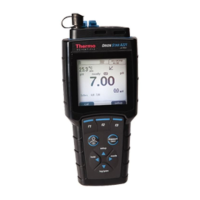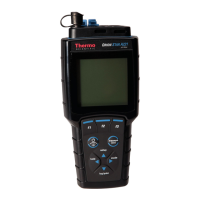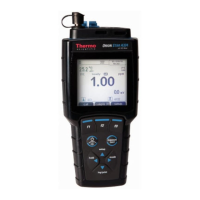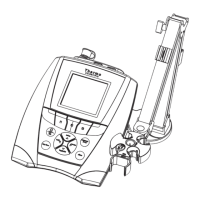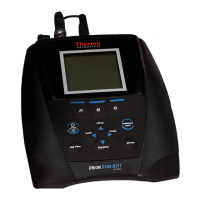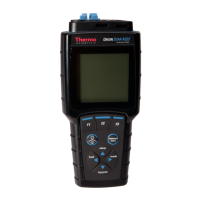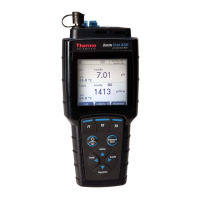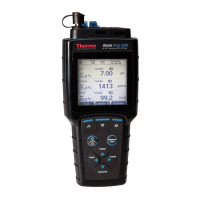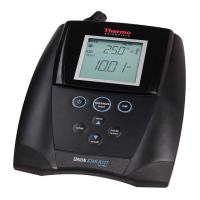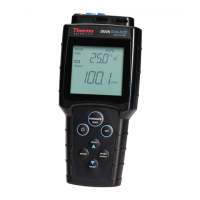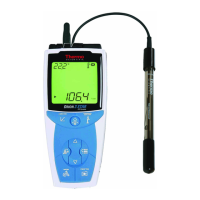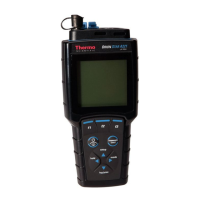
Do you have a question about the Thermo Scientific Orion Star A220 Series and is the answer not in the manual?
| pH Resolution | 0.01 pH |
|---|---|
| mV Resolution | 0.1 mV |
| Temperature Resolution | 0.1 °C |
| Temperature Accuracy | ±0.1 °C |
| Outputs | USB, RS232 |
| mV Range | ±2000.0 mV |
| mV Accuracy | ±0.2 mV |
| Temperature Range | -5.0 to 105.0 °C |
| Display | LCD |
| Calibration Points | Up to 5 points |
| Power Supply | 4 AA batteries |
Describes the meter's features, display, and user interface.
Details the items included with the Orion Star A220 series portable meters.
Specifies the proper application and limitations of the meter.
Step-by-step guide to replace the meter's batteries.
Instructions for powering the meter via an AC adapter.
Lists and describes optional accessories for portability.
Details the available ports and their functions on the meters.
Explains the function of each key on the meter.
Describes the dynamic actions of the f1, f2, f3 keys.
Explains how to interpret information shown on the meter's screen.
Identifies and explains various icons on the meter display.
Shows the icon indicating pH electrode health.
Outlines the different meter models and their measurement functions.
Provides guidelines for routine meter cleaning and care.
Entry point for accessing all meter configuration options.
Explains the icons used in the main setup menu.
Visual representation of the main setup menu hierarchy.
Flow chart for channel-specific settings.
Details settings for pH, Conductivity, and DO/RDO channels.
Customizes measurement and calibration parameters.
Configuration options specific to the pH channel.
Setting up pH buffer recognition for calibration.
Configuration options specific to the Conductivity channel.
Inputting the conductivity sensor's cell constant.
Adjusting temperature compensation for conductivity.
Selecting the type of salinity measurement.
Adjusting the factor for TDS calculation.
Specifying the conductivity sensor type.
Configuration options specific to the DO/RDO channel.
Adjusting DO readings based on barometric pressure.
Applying salinity corrections to DO readings.
Managing temperature-related settings.
Manually inputting the sample temperature.
Setting temperature display units (°C or °F).
Calibrating the meter's temperature measurement.
Configuring general meter settings like data logging and display.
Accessing and managing stored data logs.
Functionality for saving measurement data.
Storing calibration history.
Performing meter tests and system checks.
Running an automated diagnostic test.
Verifying pH measurement accuracy.
Testing the stability of connected electrodes.
Steps before measuring pH.
Detailed steps for calibrating the pH measurement.
Verifying the electrode's ability to recognize buffers.
Calibrating ORP in relative mV mode.
Calibrating ORP using EH units.
Steps for taking pH measurements.
Steps before measuring conductivity.
Detailed steps for calibrating conductivity.
Calibrating using a manual cell constant value.
Verifying the accuracy of conductivity measurements.
Steps for taking conductivity measurements.
Steps before measuring DO.
DO calibration using an air saturated atmosphere.
DO calibration using saturated water.
Alternative method for DO calibration.
Establishing a zero point for DO calibration.
Steps for taking DO/RDO measurements.
Configuring how data is saved and transferred.
Choosing between Auto-Read and Continuous modes.
Enabling and configuring the meter's data logging feature.
Configuring parameters for data export.
Illustrates data formats for transfer.
Information on connecting and using printers.
Requirements for connecting the meter to a computer.
Guide for connecting via a USB-to-Serial cable.
Guide for connecting via a standard USB cable.
Details about the data transfer software.
Connecting the meter to various software.
Rules for controlling the meter remotely.
List of commands for remote operation.
Format of measurement data via GETMEAS.
Format of calibration data via GETCAL.
Steps to update the meter's firmware.
Solutions for common meter issues.
Restoring the meter to factory default settings.
Resetting user-defined settings.
Regulatory compliance information.
Information on waste electrical equipment compliance.
Manufacturer's statement of compliance.
Technical specifications of the meter.
Detailed specs for the pH model.
Detailed specs for the Conductivity model.
Detailed specs for the DO/RDO model.
Catalog numbers for meters and kits.
List of available accessories, electrodes, and solutions.
